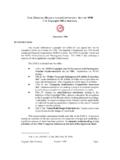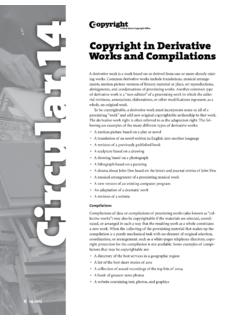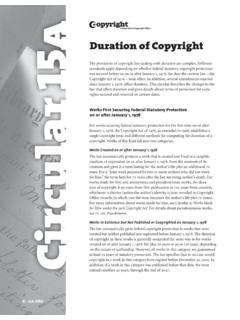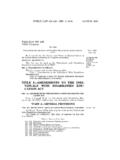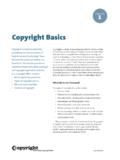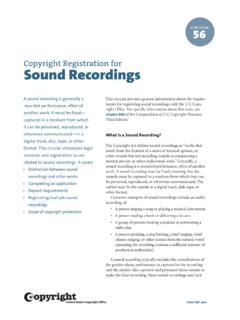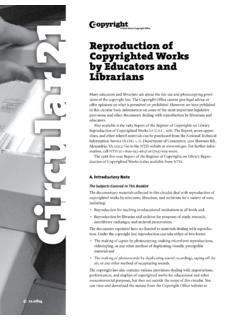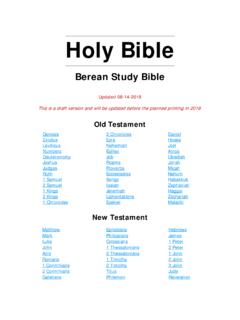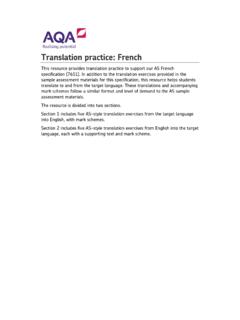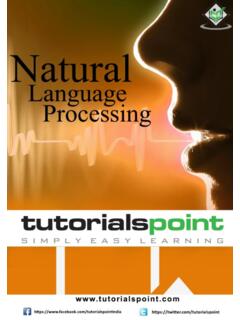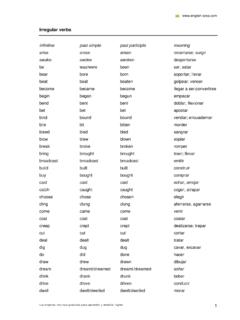Transcription of C O M P E N D I U M Glossary
1 Glossary : 1 01/28/2021 C O M P E N D I U M Glossary This Glossary provides brief definitions for certain terms as they apply to registration, recordation, and other services provided by the Copyright Office. Definitions that are taken directly from the Copyright Act, the Office s regulations, or a Supreme Court decision are enclosed in quotation marks. Definitions that are not enclosed in quotation marks are not legal definitions; they are intended to educate and inform legal practitioners and members of the public who file applications, record documents, and conduct other business with the Office.
2 1909 Copyright Act: An Act to Amend and Consolidate the Acts Respecting Copyright, Pub. L. No. 60-349, 35 Stat. 1075 (1909). This law as amended was the copyright law of the United States from July 1, 1909 through December 31, 1977. It was repealed effective January 1, 1978 and replaced with the 1976 Copyright Act. 1976 Copyright Act: Pub. L. No. 94-553, 90 Stat. 2541 (1976). Passed by Congress and effective on January 1, 1978, this law as amended is the current Copyright Law of the United States. It is codified in Title 17 of the Code. Abridgement: A shortened or condensed version of a preexisting work that retains the general sense and unity of the preexisting work.
3 Act: See 1976 Copyright Act. Annotation: A statement that the Copyright Office adds to the registration record to clarify the facts underlying the claim or to identify legal limitations on the claim. To annotate means to add an annotation to the record. Anonymous work: An anonymous work is a work on the copies or phonorecords of which no natural person is identified as author. 17 101. Appeal: See Request for reconsideration. Applicant: The party who submits an application to the Copyright Office. Applied art: Applied art is Art employed in the decoration, design, or execution of useful objects, or those arts or crafts that have a primarily utilitarian function, or the designs and decorations used in these arts.
4 Star Athletica, v. Varsity Brands, Inc., 137 S. Ct. 1002, 1014 (2017) (internal quotations and citations omitted). Architectural work: An architectural work is the design of a building as embodied in any tangible medium of expression, including a building, architectural plans, or drawings. The work includes the overall form as well as the arrangement and composition of spaces and elements in the design, but does not include individual standard features. 17 101. The Copyright Office registers as architectural works designs for structures that can be inhabited by humans or are otherwise intended CO M P E N D I U M O F C O P Y R I G H T O F F I C E P R A C T I C E S, Third Edition Glossary : 2 01/28/2021 for human occupancy.
5 Examples include houses, office buildings, churches, museums, gazebos, and garden pavilions. Audiovisual work: Audiovisual works are works that consist of a series of related images which are intrinsically intended to be shown by the use of machines or devices such as projectors, viewers, or electronic equipment, together with accompanying sounds, if any, regardless of the nature of the material objects, such as films or tapes, in which the works are embodied. 17 101. In other words, the term audiovisual works refers broadly to any work that includes any series of related visual images, whether or not moving, and with or without sounds, as long as a machine or device is essential to the viewing of the related series of images.
6 Authorized agent: Any person entitled to act on behalf of an author, a copyright claimant, or an owner of one or more of the exclusive rights. Author Created: The portion of the online application that identifies the copyrightable material created by the author named in the application. In the paper application, this portion of the application is referred to as the Nature of Authorship space. Authorship statement: The portion of the application that describes the copyrightable material created by the author named in the application. In the online application, this portion of this statement typically appears in the Author Created field and/or New Material Included field.
7 In the paper application it typically appears in the Nature of Authorship space and/or the Material Added to This Work space. Automated database: See Database. Basic registration: A registration issued on or after January 1, 1978. Berne Convention: An international treaty, the Convention for the Protection of Literary and Artistic Works, to protect literary and artistic works signed at Berne, Switzerland, on September 9, 1886, and all acts, protocols, and revisions thereto. The United States acceded to the Berne Convention and became a member on March 1, 1989. Best edition: The best edition of a work is the edition, published in the United States at any time before the date of deposit, that the Library of Congress determines to be most suitable for its purposes.
8 17 101. Board: See Review Board. CAD: An abbreviation for the Copyright Office s Copyright Acquisitions Division. Certificate of registration: An official record issued by the Copyright Office that bears the Copyright Office seal and the signature of the Register of Copyrights. The certificate denotes the fact that the Office has received a valid claim to copyright ( , an acceptable application, deposit, and filing fee) and that the claim has been registered by the Office. The certificate shows the registration number and date that the registration is effective. Provided the claim is registered before the work is published or within five years of the date on which the work is first published, the facts on a certificate of CO M P E N D I U M O F C O P Y R I G H T O F F I C E P R A C T I C E S, Third Edition Glossary : 3 01/28/2021 registration and the validity of the copyright are presumed true by courts of law unless later shown to be false.
9 Certification: 1) The act of signing an application to register a work with the Copyright Office. The individual who signs the application certifies that the information provided therein is correct to the best of his or her knowledge. 2) The preparation of a statement under the seal of the Copyright Office attesting to the authenticity of a record or report based on a search of the Office s records; a type of copyright service available for a fee. For certifications provided in connection with the recordation of a transfer of copyright ownership or other documents pertaining to copyright, see Sworn certification and Official certification.
10 Choreographic works: The term choreography is derived from the Greek words choreia, meaning dance, and graphikos, meaning to write. A dance is a static and kinetic succession of bodily movements in certain rhythmic and spatial relationships and in relation to time and space. Choreography is the composition and arrangement of a related series of dance movements and patterns organized into a coherent whole. Choreography is not synonymous with dance. It is a discrete subset of dance that encompasses certain types of compositional dances. For example, the legislative history for the 1976 Copyright Act states that choreographic works do not include social dance steps and simple routines.
